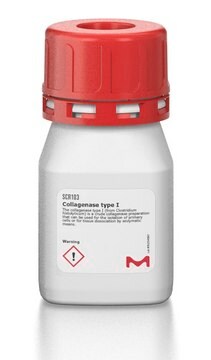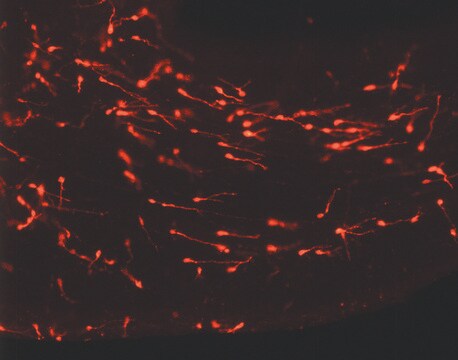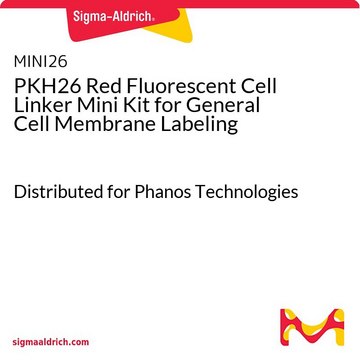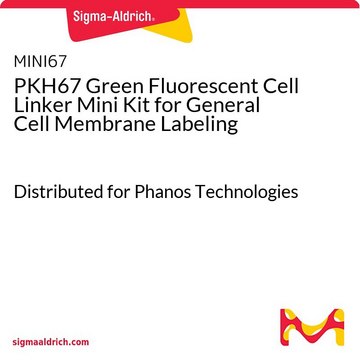D4292
3,3′-Dioctadecyloxacarbocyanine perchlorate
≥98% purity (TLC), powder
Sinónimos:
DiOC18(3), ‘DiO’
About This Item
Productos recomendados
Nombre del producto
3,3′-Dioctadecyloxacarbocyanine perchlorate,
assay
≥98% (TLC)
Quality Level
form
powder
technique(s)
titration: suitable
color
orange
solubility
chloroform: 50 mg/mL
fluorescence
λex 484 nm; λem 501 nm in methanol
application(s)
diagnostic assay manufacturing
hematology
histology
storage temp.
2-8°C
SMILES string
[O-]Cl(=O)(=O)=O.CCCCCCCCCCCCCCCCCCN1C(\Oc2ccccc12)=C/C=C/c3oc4ccccc4[n+]3CCCCCCCCCCCCCCCCCC
InChI
1S/C53H85N2O2.ClHO4/c1-3-5-7-9-11-13-15-17-19-21-23-25-27-29-31-37-46-54-48-40-33-35-42-50(48)56-52(54)44-39-45-53-55(49-41-34-36-43-51(49)57-53)47-38-32-30-28-26-24-22-20-18-16-14-12-10-8-6-4-2;2-1(3,4)5/h33-36,39-45H,3-32,37-38,46-47H2,1-2H3;(H,2,3,4,5)/q+1;/p-1
InChI key
GFZPJHFJZGRWMQ-UHFFFAOYSA-M
¿Está buscando productos similares? Visita Guía de comparación de productos
Application
Biochem/physiol Actions
signalword
Warning
hcodes
Hazard Classifications
Eye Irrit. 2 - Skin Irrit. 2 - STOT SE 3
target_organs
Respiratory system
Storage Class
11 - Combustible Solids
wgk_germany
WGK 3
flash_point_f
Not applicable
flash_point_c
Not applicable
ppe
dust mask type N95 (US), Eyeshields, Gloves
Elija entre una de las versiones más recientes:
¿Ya tiene este producto?
Encuentre la documentación para los productos que ha comprado recientemente en la Biblioteca de documentos.
Los clientes también vieron
Artículos
Nitric oxide (NO) as a signal transporter in neurons, endothelial cells and in the immune system.
Nuestro equipo de científicos tiene experiencia en todas las áreas de investigación: Ciencias de la vida, Ciencia de los materiales, Síntesis química, Cromatografía, Analítica y muchas otras.
Póngase en contacto con el Servicio técnico










